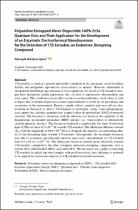| dc.contributor.author | Jijana, Abongile Nwabisa | |
| dc.date.accessioned | 2023-03-22T09:45:59Z | |
| dc.date.available | 2023-03-22T09:45:59Z | |
| dc.date.issued | 2023 | |
| dc.identifier.citation | Jijana, A.N. (2023).Polyaniline entrapped water-dispersible 3mpa-znse quantum dots and their application for the development of an enzymatic electrochemical nanobiosensor for the detection of 17β-estradiol, an endocrine-disrupting compound. Applied Biochemistry and Biotechnology. DOI: 10.1007/s12010-022-04277-w | en_US |
| dc.identifier.uri | 10.1007/s12010-022-04277-w | |
| dc.identifier.uri | http://hdl.handle.net/10566/8637 | |
| dc.description.abstract | 17β-estradiol is used as a growth and fertility stimulant in the agronomic sector to induce fertility and manipulate reproductive characteristics in animals. However, unintended or unregulated distribution and exposure to even significant low levels of 17β-estradiol estrogen have detrimental health implication that can lead to reproductive abnormalities and even cancer. This could have severe effect on the ecosystem imbalance, food safety, to such a degree that its health impact necessitates rapid methods to probe for its prevalence and occurrence in the environment. Herein a simple, robust, sensitive and once-off use electrochemical biosensor to detect 17β-estradiol is developed, using 3-mercaptopropionic acid capped zinc selenide quantum dots trapped within the polyaniline (PANI) framework structure. The biosensor’s interaction with the substrate was based on the capability of the hemeprotein, horseradish peroxidase (HRP) enzyme (i.e., baroreceptor) to alternatively catalyze phenolic alcohols. The biosensor displayed a significantly low limit of detection limit (LOD) of value 0.2 × 10−6 M towards 17β-estradiol. The Mechaelis-Menten constant (Km) with the magnitude of 0.64 × 10−6 M was obtained; this indicates an outstanding affinity of the biosensing films towards 17β-estradiol. Subsequently, the developed biosensor was able to accurately and efficiently measure successive concentrations of 17β-estradiol from 0.2 × 10 to 4 × 10−6 M. The fabricated biosensor showed good selectivity towards 17β-estradiol compared to the other estrogenic endocrine-disrupting compounds such as estrone (E1), ethnylstradiol (EE2), and estriol (E3). The biosensor was capable of detecting 17β-estradiol in spiked tap water samples with good recoveries, thus affirming its potential to be applied for real electro-analysis of 17β-estradiol in treated wastewater. | en_US |
| dc.publisher | SpringerLink | en_US |
| dc.subject | Estrogenic endocrine-disrupting compounds (e-EDC) | en_US |
| dc.subject | 17β-estradiol (E2); hormone replacement therapy (HRT) | en_US |
| dc.subject | Quantum dots | en_US |
| dc.subject | Polymer nanocomposites | en_US |
| dc.subject | Polyaniline (PANI) | en_US |
| dc.subject | Electrochemical biosensors | en_US |
| dc.title | Polyaniline entrapped water-dispersible 3mpa-znse quantum dots and their application for the development of an enzymatic electrochemical nanobiosensor for the detection of 17β-estradiol, an endocrine-disrupting compound | en_US |
| dc.type | Article | en_US |

